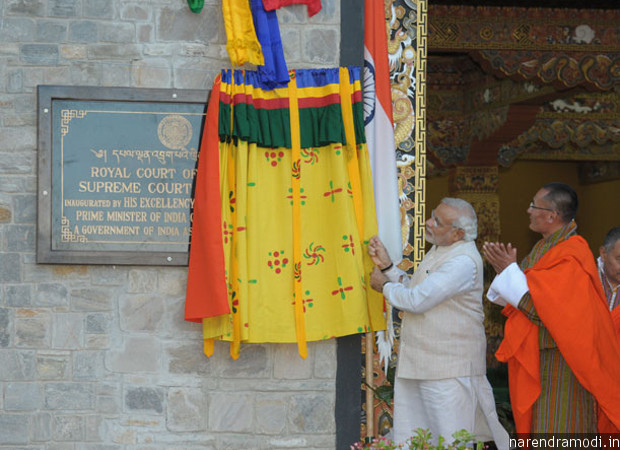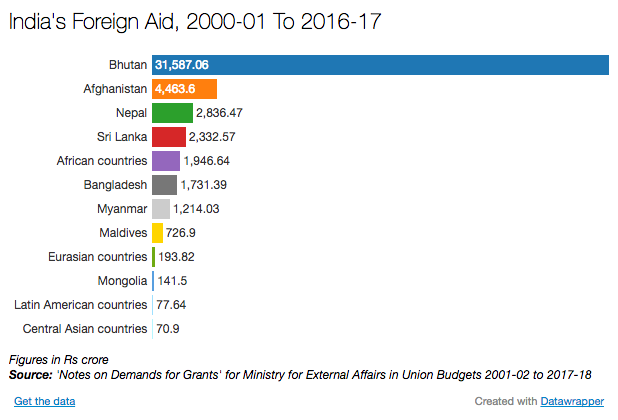Afghanistan, Africa New Priorities, But A Small Monarchy Remains India’s Top Foreign-Aid Priority
Bhutanese prime minister Tshering Tobgay applauds as Indian prime minister Narendra Modi inaugurates the Supreme Court building of Bhutan, in June 2014. Bhutan received over two-thirds of India's foreign aid between 2001 and 2017.
The monarchy of Bhutan has remained the biggest beneficiary--by amount and share--of Indian foreign aid for 17 years, but over the last nine years, Afghanistan has made it to the distant second spot, preferred over traditional recipients Nepal and Bangladesh, according to an IndiaSpend analysis of Indian foreign ministry data1.
Although its share of foreign aid is falling and that of African countries, listed as a group, is growing, Bhutan has remained India’s unfailing priority because of its strategic location, its dependence on India and its hydropower potential. Indian aid to Sri Lanka and the Maldives increased fastest, according to aid data between the financial years 2000-01 and 2016-17.
Source: Notes on Demands for Grants for Ministry for External Affairs in Union Budgets1
However, the averages over this period conceal substantial fluctuations in aid. For instance, while aid to Sri Lanka fell 69% year-on-year in the financial year 2016-17, it rose 118% and 166% in 2012-13 and 2009-10, respectively. Similarly, while aid to the Maldives rose 45% in the financial year 2016-17, it dropped 89% in 2012-13 after rising nearly 25 times in the previous year.
Among the countries to have benefited most by India’s reallocation of aid is Afghanistan.
In eight of last 10 years, Afghanistan makes it to second spot
Before the financial year 2007-08, the foreign ministry did not even report aid for Afghanistan individually. Since then, it has been the second biggest beneficiary, by share, in eight of the following 10 years.
In the pre-2007-08 period, Nepal was the second-largest recipient in all years except three, when Bangladesh held that position. Over the 17 years we analysed, Afghanistan received the least aid of the 12 major regions reported by the ministry, the allocation shrinking more than a quarter by amount.
How India's Foreign Aid Priorities Changed,2000-01 To 2016-17
Source: Notes on Demands for Grants for Ministry for External Affairs in Union Budgets1Note: Please choose 'Unique Colors' under the 'Color' dropdown, 'Foreign Aid (As % of total)' under the 'Size' dropdown. Year denoted is financial year.
Among regions for which the ministry reports data as a group, African countries are the only significant beneficiaries: India's aid to African countries grew 57 times between 2000-01 and 2016-17, the share rising 4.38 percentage points over the same period. African countries, as a group, were the second biggest beneficiary in 2003-04 and 2004-05 among all regions, countries as well as groups of countries, taken together.
The only constant in this story is Bhutan, but other countries in other regions have been eating into its share at a time when questions are being raised about India’s policy of aid to Bhutan’s hydropower sector. By change in share over the 17 years, it is better only than Afghanistan, with Bhutan’s aid having fallen by 10.45 percentage points.
Notes:
1. Data source: Notes on Demands for Grants for Ministry for External Affairs in Union Budgets 2001-02, 2002-03, 2003-04, 2004-05, 2005-06, 2006-07, 2007-08, 2008-09, 2009-10, 2010-11, 2011-12, 2012-13, 2013-14, 2014-15, 2015-16, 2016-17, 2017-18
2. Figures for Afghanistan are for financial years 2007-08 to 2016-17. Central Asian countries region dropped after financial year 2007-08. Figures for Eurasian countries are for financial years 2008-09 to 2016-17 only. Figures for Latin American countries are for financial years 2007-08 to 2016-17 only. Figures for Mongolia are for financial years 2009-10, and 2011-12 to 2016-17 only.
3. Central Asian countries include Azerbaijan, Kazakhstan, Kyrgyzstan, Tajikistan, Turkey, Turkmenistan, Uzbekistan. Eurasian countries include Russia, Armenia, Azerbaijan, Belarus, Kazakhstan, Georgia, Kyrgyz, Tajikistan, Turkmenistan, Ukraine, Uzbekistan.
Correction: An earlier version of this story erroneously identified Bhutanese prime minister Tshering Tobgay as the country's monarch at the time, King Jigme Khesar Namgyel Wangchuck, in the cover image. We regret the error.
(Vivek is an analyst with IndiaSpend.)
We welcome feedback. Please write to respond@indiaspend.org. We reserve the right to edit responses for language and grammar.
__________________________________________________________________
“Liked this story? Indiaspend.org is a non-profit, and we depend on readers like you to drive our public-interest journalism efforts. Donate Rs 500; Rs 1,000, Rs 2,000.”




